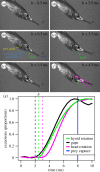Extremely fast feeding strikes are powered by elastic recoil in a seahorse relative, the snipefish, Macroramphosus scolopax
- PMID: 30051834
- PMCID: PMC6053929
- DOI: 10.1098/rspb.2018.1078
Extremely fast feeding strikes are powered by elastic recoil in a seahorse relative, the snipefish, Macroramphosus scolopax
Abstract
Among over 30 000 species of ray-finned fishes, seahorses and pipefishes have a unique feeding mechanism whereby the elastic recoil of tendons allows them to rotate their long snouts extremely rapidly in order to capture small elusive prey. To understand the evolutionary origins of this feeding mechanism, its phylogenetic distribution among closely related lineages must be assessed. We present evidence for elastic recoil-powered feeding in snipefish (Macroramphosus scolopax) from kinematics, dynamics and morphology. High-speed videos of strikes show they achieve extremely fast head and hyoid rotational velocities, resulting in rapid prey capture in as short a duration as 2 ms. The maximum instantaneous muscle-mass-specific power requirement for head rotation in snipefish was above the known vertebrate maximum, which is evidence that strikes are not the result of direct muscle power. Finally, we show that the over-centre conformation of the four-bar linkage mechanism coupling head elevation to hyoid rotation in snipefish can function as a torque reversal latch, preventing the head from rotating and providing the opportunity for elastic energy storage. The presence of elastic recoil feeding in snipefish means that this high-performance mechanism is not restricted to the Syngnathidae (seahorses and pipefish) and may have evolved in parallel.
Keywords: Syngnathiformes; over-centre latch; suction feeding; torque reversal; trigger mechanism.
© 2018 The Author(s).
Conflict of interest statement
We declare we have no competing interests.
Figures




References
-
- Gronenberg W. 1996. Fast actions in small animals: springs and click mechanisms. J. Comp. Physiol. A 178, 727–734. (10.1007/BF00225821) - DOI
MeSH terms
Associated data
LinkOut - more resources
Full Text Sources
Other Literature Sources

